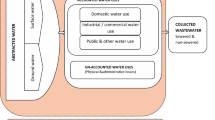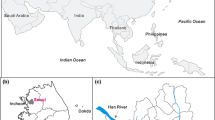Abstract
Monitoring and minimizing tourist’s water consumption is essential for the sustainable development of mountain destinations in the world. However, available data and a generally accepted protocol on such measurement are still limited. This study uses water footprint accounting to quantify tourist’s water demand in the Liming valley, a World Heritage site and a rapidly growing tourism destination in Northwest Yunnan, China. Both the water for direct and indirect use is taken into account based on the consumptive behavior of the tourists in the valley. Data were collected through guesthouse monitoring and a tourist survey in the 2005 tourist season. The results indicate that an average tourist leaves behind a footprint of 5.2 m3 on local water resources per day. Food production and waste dilution are the two most important water consumption factors. The results also show tourists consume more water than the local residents on per capita basis. This suggests more commitment is necessary to cope with this stress by individual tourists. Management implications to make water use more sustainable in mountain destinations are derived from this study.
Similar content being viewed by others
References
Allen RG, Pereira LS, Raes D, Smith M (1998) Crop Evapotranspiration: Guideline for Computing Crop Water Requirements. FAO irrigation and drainage paper 56. Rome, Italy: FAO.
Almeida MC, Butler D, Friedler E (1999) At-source domestic wastewater quality. Urban Water 1(1): 49–55.
Baker BB, Moseley RK (2007) Advancing treeline and retreating glaciers: Implications for conservation in Yunnan, P.R. China. Arctic, Antarctic, and Alpine Research 39(2): 200–209.
Beniston M (2003) Climatic change in mountain regions: A review of possible impacts. Climatic Change 59:5–31.
Boselli AM, Caravello GU, Baroni A (2005) The upper Mustang (Nepal) ecosystem: Population, water quality and tourism. Aquatic Ecosystem Health & Management 8(3): 285–291.
Buntaine MT, Mullen RB, Lassoie JP (2007) Human use and conservation planning in alpine areas of Northwestern Yunnan, China. Environment, Development and Sustainability 9(3): 305–324.
Burkhard R, Deletic A, Craig A (2000) Techniques for water and wastewater management: A review of techniques and their integration in planning. Urban Water 2(3): 197–221.
Chambers N, Simmons C, Wackernagel M (2000) Sharing Nature’s Interest: Ecological Footprints as an Indicator of Sustainability. London, United Kingdom: EarthScan.
Chapagain AK, Hoekstra AY (2004) Water Footprints of Nations. Value of water research report (series no.16). Delft, the Netherlands: UNESCO-IHE.
Chanpagain AK, Hoekstra AY (2007) The water footprint of coffee and tea consumption in the Netherlands. Ecological Economics 64(1): 109–118.
Chapagain AK, Hoekstra AY, Savenije HHG, Gautam R (2006) The water footprint of cotton consumption: An assessment of the impact of worldwide consumption of cotton products on the water resources in the cotton producing countries. Ecological Economics 60(1): 186–203.
Daby D, Turner J, Jago C (2002) Microbial and nutrient pollution of coastal bathing waters in Mauritius. Environment International 27(7): 555–566.
Draper D (1997) Touristic development and water sustainability in Banff and Canmore, Alberta, Canada. Journal of Sustainable Tourism 5(3): 183–212.
Essex S, Kent M, Newnham R (2004) Tourism development in Mallorca: Is water supply a constraint? Journal of Sustainable Tourism 12(1):4–28.
Fortuny M, Soler R, Canovas C, Sanchez A. (2008) Technical approach for a sustainable tourism development: Case study in the Balearic Islands. Journal of Cleaner Production 16(7): 860–869.
Fower R, Rockstrom J (2001) Conservation tillage for sustainable agriculture: An agrarian revolution gathers momentum in Africa. Soil and Tillage Research 61(1–2): 93–108.
Gerbens-Leenes PW, Nonhebel S, Ivens WPMP (2002) A method to determine land requirements relating to food consumption patterns. Agriculture, Ecosystem and Environment 90(1): 47–58.
Gossling S (2001) The consequences of tourism for sustainable water use on a tropical island: Zanzibar, Tanzania. Journal of Environmental Management 61(2): 179–191.
Gossling S (2005) Tourism and water. In: Gossling S, Hall CM, editors. Tourism and Global Environmental Change: Ecological, Social, Economic and Political Interrelationships. London, United Kingdom: Routledge, pp180–194.
He YL, Zhang YP (2005) Climate Change from 1960 to 2000 in the Lancang River Valley, China. Mountain Research and Development 25(4): 341–348.
Hench KR, Bissonnette GK, Sexstone AJ, Coleman JG, Garbutt K, Skousen JG (2003) Fate of physical, chemical, and microbial contaminants in domestic wastewater following treatment by small constructed wetlands. Water Research 37(4): 921–927.
Hoekstra AY (2009) Human appropriation of natural capital: Comparing ecological footprint and water footprint analysis. Ecological Economics 68(7): 1963–1974.
Hoekstra AY, Chapagain AK (2008) Globalization of Water: Sharing the Planet’s Freshwater Resources. Oxford, United Kingdom: Blackwell.
Hoekstra AY, Chapagain AK (2007) Water footprints of nations: Water use by people as a function of their consumption pattern. Water Resources Management 21(1): 35–48.
Hoekstra AY, Hung PQ (2002) Virtual Water Trade: A Quantification of Virtual Water Flows between Nations in Relation to International Crop Trade. Value of water research report (series no.11) Delft, the Netherlands: UNESCO-IHE.
Kent M, Newnham R, Essex S (2002) Tourism and sustainable water supply in Mallorca: A geographical analysis. Applied Geography 22(4):351–374.
Lemly AD, Kingsford RT, Thompson JR (2000) Irrigated agriculture and wildlife conservation: Conflict on a global sale. Environmental Management 25(5): 485–512.
Li P, Yang GH (2007) Ecological footprint study on tourism itinerary products in Shangri-La, Yunnan Province, China. Acta Ecologica Sinica 27(7): 2954–2963.
Li SJ, He DM (2008) Water level response to hydropower development in the upper Mekong river. AMBIO 37(3): 170–176.
Liu J, Savenije HHG (2008) Food consumption patterns and their effect on water requirement in China. Hydrology and Earth System Sciences 12(3): 887–898.
Ma X, Xu JC, Qian J (2008) Water resource management in a middle mountain watershed: A case study in Xizhuang, Yunnan, China. Mountain Research and Development 28(3/4): 286–291.
Merz J, Nakarmi G, Shrestha SK, Dahal BM, Dangol PM, Dhakal MP, Dongol BS, Sharma S, Shah PB, Weingptner R (2003) Water: A scare resource in rural watersheds of Nepal’s middle mountains. Mountain Research and Development 23(1): 41–49.
NEPB [National Environmental Protection Bureau] (1998) Integrated Wastewater Discharge Standard. Beijing, China: Chinese Environmental Press. [In Chinese]
Nyaupane GP, Morais DB, Dowler L (2006) The role of community involvement and number/type of visitors on tourism impacts: A controlled comparison of Annapurna, Nepal and Northwest Yunnan, China. Tourism Management 27(6): 1373–1385.
Peng H (2000) A survey of the Danxia landform research in China [in Chinese with English abstract]. Scientia Geographica Sinica 20(3): 203–211.
Peng SL, Li FR, Zhou T, Chen LF, Chen BM, Peng H (2008) The ecological ravine effects of Danxia landform [in Chinese with English abstract]. Acta Ecologica Sinica 28(7): 2947–2953.
Renault D, Wallender WW (2000) Nutritional water productivity and diets. Agricultural Water Management 45(3): 275–296.
Rijsberman FR (2006) Water scarcity: Fact or fiction? Agricultural Water Management 26(1): 5–22.
Sokhem P, Sunada K, Oishi S (2007) Managing transboundary rivers: The case of the Mekong river basin. Water International 32(4): 503–523.
Trung DN, Kumar S (2005) Resource use and waste management in Vietnam hotel industry. Journal of Cleaner Production 13(2): 109–116.
Warnken J, Bradley M, Guilding C (2005) Eco-resorts vs. mainstream accommodation providers: An investigation of the viability of benchmarking environmental performance. Tourism Management 26 (3): 367–379.
Westarp VS, Chieng S, Schreier H (2004) A comparison between low-cost drip irrigation, conventional drip irrigation, and hand watering in Nepal. Agricultural Water Management 64(2): 143–160.
WWF [World Wide Fund for Nature] (2004) Freshwater and Tourism in the Mediterranean. Rome, Italy: WWF Mediterranean Programme.
Yin YH, Wu SH, Zheng D, Yang, QY (2008) Radiation calibration of FAO 56 Penman-Monteith model to estimate reference crop evapotranspiration in China. Agricultural Water Management 95(1): 77–84.
YPWRD [Yunnan Provincial Water Resources Department] (2006) Yunnan Water Resources Bulletin [In Chinese]. Kunming, China: YPWRD.
Author information
Authors and Affiliations
Corresponding author
Rights and permissions
About this article
Cite this article
Yang, M., Hens, L., De Wulf, R. et al. Measuring tourist’s water footprint in a mountain destination of Northwest Yunnan, China. J. Mt. Sci. 8, 682–693 (2011). https://doi.org/10.1007/s11629-011-2062-2
Received:
Accepted:
Published:
Issue Date:
DOI: https://doi.org/10.1007/s11629-011-2062-2




